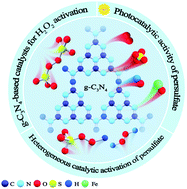Recent advances in graphitic carbon nitride as a catalyst for heterogeneous Fenton-like reactions
Abstract
Graphitic carbon nitride (g-C3N4), an appealing metal-free polymer, has featured in extensive research in heterogeneous Fenton-like reactions owing to its advantages of stable chemical and thermal properties, ease of structural regulation and unique redox ability. However, there are still some gaps in the understanding of the mechanism and fate of g-C3N4 and its derivatives in heterogeneous Fenton reaction degradation of contaminants. This paper gives systematic emphasis to the development and progress of g-C3N4 and its composites as catalysts in heterogeneous Fenton-like reactions. The main synthesis strategies of g-C3N4 composites are discussed, including calcination, hydrothermal method and self-assembly method. Then, the key catalytic properties of g-C3N4 in Fenton-like applications, including anchoring nanoparticles, increasing specific surface area and exposed active surface sites, as well as regulating charge transfer reactions, are highlighted. Special emphasis is placed on its multifunctional role in heterogeneous Fenton-like reactions and the mechanisms involved in the activation of hydrogen peroxide, persulfates, and photocatalytic activation of persulfate. Lastly, the existing challenges and possible development direction of g-C3N4-coupling Fenton reactions are proposed. It is believed that this paper will bring useful information for the development of graphitic carbon nitride in both laboratory studies and practical applications.

- This article is part of the themed collection: 2021 Frontier and Perspective articles


 Please wait while we load your content...
Please wait while we load your content...